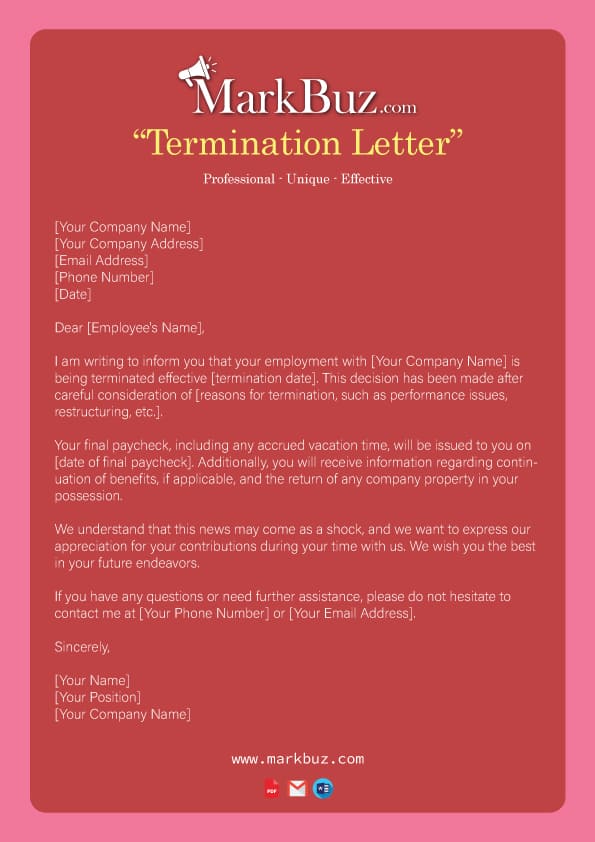Writing a termination letter may seem daunting, but it is an essential part of business operations. In this blog post, we’ll guide you through the process of crafting a professional and respectful termination letter that protects both the company and the employee.
Writing a termination letter can be a challenging task for any employer or HR professional. It’s crucial to handle the process with care, sensitivity, and professionalism to ensure a smooth transition for both the terminated employee and the organization. In this blog post, we will walk you through the essential steps and best practices for crafting a well-written termination letter.
How To Write Termination Letter?
Let us explain you how to write professional, well written and effective termination letter. The purpose could be the different for different people but a well written letter ensure a smooth transition for both the terminated employee and the organization.
Understand the Purpose of the Letter
- The termination letter serves as an official document that communicates the decision to terminate an employee.
- It provides clarity on the reasons for termination and any relevant information about the process.
- Understanding the purpose of the letter is crucial for ensuring that the message is clear and concise.
Choose the Right Tone and Language
- When writing a termination letter, it’s essential to maintain a professional and respectful tone.
- Use simple and straightforward language to convey the message without being overly harsh or emotional.
- Avoid using jargon, buzzwords, or any language that could be misinterpreted or cause confusion.
Understand the Situation
- Before you begin drafting the termination letter, make sure you have a clear understanding of why the decision is being made.
- Consider any legal obligations, company policies, and relevant documentation that need to be referenced.
Choose the Right Format
- Start with a professional letterhead that includes the company name, address, and contact information.
- Use a formal tone throughout the letter, but ensure that the language is straightforward and easy to understand.
- Include the recipient’s name, title, and contact information for a personalized touch.
State the Reason Clearly
- Be direct and concise when explaining the reason for the termination.
- Avoid using language that may be perceived as discriminatory, inflammatory, or disrespectful.
- Provide specific examples or evidence to support the decision.
Offer Support and Resources
- Express empathy and offer assistance to the recipient during the transition period.
- Provide information on any benefits, severance packages, or support services available.
- Encourage the recipient to ask questions or seek clarification if needed.
Set Expectations and Next Steps
- Clearly outline the logistics of the termination, including the last working day, return of company property, and any required paperwork.
- Provide information on how the recipient can access references or recommendations in the future.
- Discuss any non-disclosure or non-compete agreements that may apply.
Termination Letter Templates
Here are some examples how to write an effective termination letter:
Example 1
[Your Company Name] [Your Company Address] [Email Address] [Phone Number] [Date] [Employee's Name] [Employee's Address] Dear [Employee's Name], I am writing to inform you that your employment with [Your Company Name] is being terminated effective [termination date]. This decision has been made after careful consideration of [reasons for termination, such as performance issues, restructuring, etc.]. Your final paycheck, including any accrued vacation time, will be issued to you on [date of final paycheck]. Additionally, you will receive information regarding continuation of benefits, if applicable, and the return of any company property in your possession. We understand that this news may come as a shock, and we want to express our appreciation for your contributions during your time with us. We wish you the best in your future endeavors. If you have any questions or need further assistance, please do not hesitate to contact me at [Your Phone Number] or [Your Email Address]. Sincerely, [Your Name] [Your Position] [Your Company Name]
Example 2
[Your Company Name] [Your Company Address] [Email Address] [Phone Number] [Date] [Employee's Name] [Employee's Address] Dear [Employee's Name], I regret to inform you that your employment with [Your Company Name] is terminated effective immediately due to [reason for termination]. Please arrange for the return of any company property in your possession at your earliest convenience. Sincerely, [Your Name] [Your Position] [Your Company Name]
Things to keep in mind while writing termination letter
Writing a termination letter can be a challenging task. It’s important to handle such situations with care and professionalism to ensure a smooth transition for both the employer and the employee. Here are some key things to keep in mind while drafting a termination letter.
Be Clear and Direct
Be clear and direct in your communication. Clearly state the reason for termination and provide any necessary details regarding the decision.
Include Relevant Information
Make sure to include information such as the employee’s name, position, and the effective date of termination. This will help avoid any confusion and ensure that all necessary details are provided.
Maintain Professionalism
It’s important to maintain professionalism throughout the termination letter. Avoid using emotional language or making personal attacks. Stick to the facts and keep the tone businesslike.
Offer Support and Guidance
While it’s important to be direct, it’s also important to offer support and guidance to the employee. Let them know what resources are available to help them during this transition period.
Keep it Concise
Keep the termination letter concise and to the point. Avoid unnecessary details or lengthy explanations. Focus on communicating the key information clearly and effectively.
Follow Company Policies and Procedures
Make sure to follow your company’s policies and procedures when drafting a termination letter. This will help ensure that the process is handled in a consistent and fair manner.
Provide Next Steps
In the termination letter, provide information on next steps for the employee, such as the final paycheck, benefits, and any other relevant details. This will help the employee understand what to expect moving forward.
Show Empathy
Show empathy and understanding in the termination letter. Acknowledge the impact that this decision may have on the employee and offer support wherever possible.
Remember, writing a termination letter is a sensitive task that requires compassion and professionalism. By keeping these key points in mind, you can ensure that the process is handled with care and respect.
Tips for Writing a Termination Letter
- Start with a Clear Statement: Begin the letter by clearly stating the reason for termination. Be concise and avoid judgmental language.
- Provide Relevant Details: Include relevant details such as the employee’s name, position, and the effective date of termination. This ensures the letter is specific and leaves no room for confusion.
- Express Empathy: While it’s important to be direct, it’s also crucial to express empathy towards the employee. Acknowledge the difficulty of the situation and offer support where appropriate.
- Outline Next Steps: Clearly outline the next steps for the employee, such as the final paycheck, benefits, and any severance packages. This helps the employee understand what to expect after termination.
- Maintain Professionalism: Maintain a professional tone throughout the letter. Avoid using harsh language or making personal attacks. Focus on the facts and keep emotions in check.
Conclusion
Writing a termination letter is a challenging task, but by following these steps, you can ensure that the process is handled professionally and respectfully. Remember to approach the situation with empathy and understanding, and always prioritize clear communication. By carefully crafting a termination letter, you can mitigate potential conflicts and ensure a smooth transition for all parties involved.





